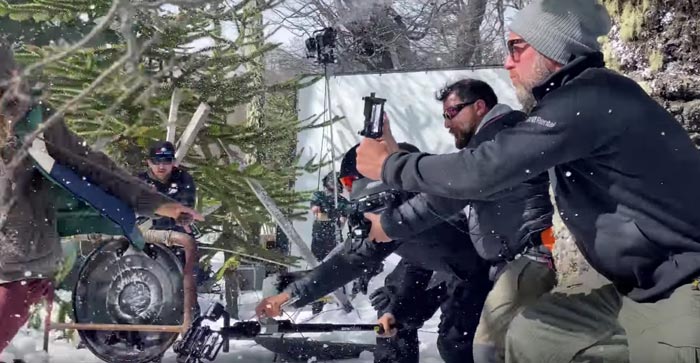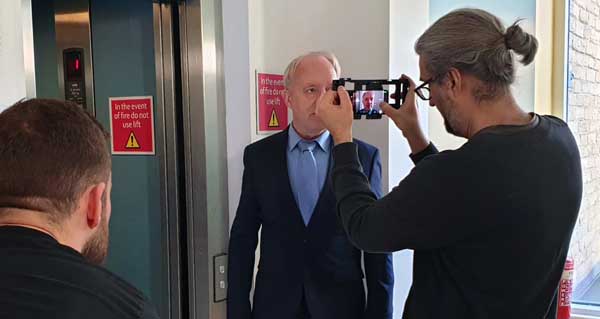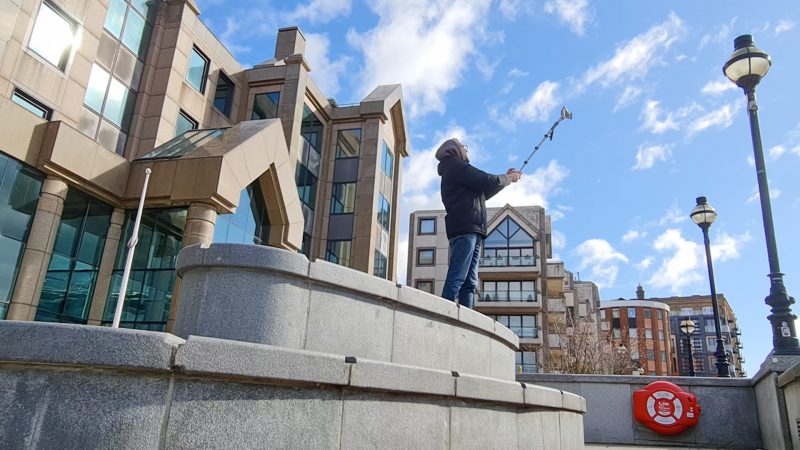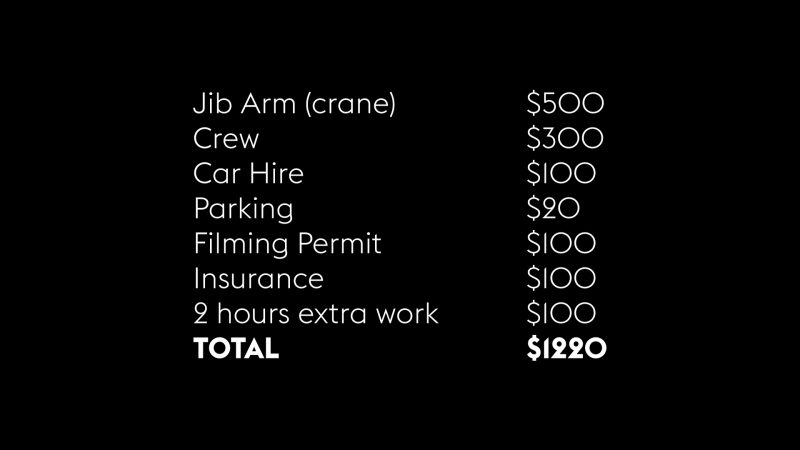Why Cinematography is NOT About your Camera
Every time someone clicks on one of my affiliate links and buys a DSLR camera, I earn about $40-50. So I’d be pretty dumb to tell you you don’t need one, right?
Well. Guess what. You don’t need one.
There’s some arguments out there that you need a “professional” camera to shoot a professional movie. And in this article, I’m going to debunk a few of those.
The Shot on iPhone “Fraud”
People who argue that you need a DSLR or Blackmagic to shoot a professional looking movie, often claim, “Well, those shot on iPhone films are not just the iPhone. They have a whole crew and extra kit.”
Well, yes. Quite often they do.
But doesn’t that actually debunk their own claim? If it’s about professional lighting and professional crew then, logically, it’s not about the camera. And this professional kit and crew is often out of the reach of us low budget filmmakers.
So what is their point? The point they are unintentionally making is that filmmaking is about skills over everything else. And NOT the camera.

And what is the best way to learn those skills? By practicing, of course.
Does buying a DSLR enable you to practice more? Not really. Perhaps even less, because you don’t always have it with you.
With a smartphone and an app like FiLMiC Pro, I can grab some filmmaking practice on the spur of the moment. If I see something inspiring, it’s right there. I don’t have to run home to grab my professional camera.
Highest Image Quality Wins
If we agree that having a large sensor and a wide dynamic range is the key to great cinema, that then destroys about 100 years of cinema history. Film stocks that have been used, up until about the 1990s or even later, had less dynamic range than your current iPhone sensor.
That means films like The Godfather, Taxi Driver, Star Wars, Citizen Kane are bad films, because they were shot with film stock we would now consider low quality.

But why doesn’t my iPhone video look as beautiful as The Godfather, you ask? Because you’re not controlling the lighting to the extent they did, or because you haven’t learned the skills yet. Of course, we can’t ignore the look prime lenses give to The Godfather.
By the way, the 35mm Super Baltar Prime Lenses used to shoot The Godfather are quoted for hire in London at £260 per day. And the fact is, your iPhone plus the Baltar Primes using an adapter of some kind, will probably look more like The Godfather than a DSLR with a £100 lens.
The point here is that most of us cannot afford those lenses, we can’t afford a lighting crew, and we can’t afford a big lighting rig.
A DSLR is Cheaper than a Smartphone
Well, yes, this can be true. If you only bought your smartphone to shoot video with. But who does that? Nobody.
Why do you have a smartphone? Most likely because you want or need one for every day life. Like me, you probably use it for surfing the web, banking, emails, social media, watching movies and much more.
There’s a good chance that, right now, you’re reading this article on your smartphone. Hands up who’s reading this on a DSLR… Yeah. Thought not.
Can you watch YouTube videos on your DSLR? Or post to Facebook and Instagram with it? No.
Of course, nearly all of us have a smartphone already. So, in a sense it’s a free cinema camera. You may end up spending a bit more, because you want the extra camera features. You might spend, say, an extra $500.
That means a DSLR and lens setup has to come in at less than $500 to work out cheaper.

Second hand?
“Well, you can get a good one 2nd hand”, the argument goes.
Of course you can also get a smartphone 2nd hand. A 2nd hand iPhone 8+ will cost you about £250.
Thing is, it doesn’t stop there. Once you have a DSLR, if you want a gimbal as well, it will be bigger and more expensive. If you want a tripod – bigger, more expensive. Anamorphic adapter – bigger and more expensive.
And a Blackmagic setup is going to set you back even more. To quote No Film School from their blog: “The bummer about that is that all of the excitement of buying a crazy inexpensive 6K camera kind of dissipates quickly when you see the real cost of outfitting it to withstand the demands of a professional shoot.”
And what’s really important is this: even if you had this great Blackmagic setup, you still need lights. You still need knowledge. In fact, you need more knowledge, as a Blackmagic setup is somewhat more complicated to use.
The question is: are you really going to learn filmmaking quicker using this kit?
Time Is Money
You know, the fact that time equals money cannot be ignored. Even if a DSLR turned out to be the same cost as a smartphone (it’s not, but just say it was), ask yourself which device is quicker to film with?
If you can shoot something quicker with a smartphone then you’re saving money. How much value do you place on your time? $10 an hour? $20? $50?
What is it that actually stops you making movies, anyway? My bet is, one of the most common reasons is we can’t afford the time. And also, what if your client can’t afford to pay you for all that time?
Well, if you reduce the time you spend filming and editing, you can bring your budget down to fit a whole new client base.
So then, can we shoot a movie on a smartphone? The short answer is, yes of course. The longer answer is, well – it depends. So let’s look into this…
Can I Shoot a Movie on a Smartphone?
Really, the question is not “can you?”, but “should you?”
And the answer depends on you, the film and what you hope to achieve with it.
If you’re hoping to shoot a feature film and sell it to Netflix, like Steven Soderbergh, you’re probably going to be out of luck. The fact is, since Soderbergh shot High Flying Bird for Netflix, there hasn’t been a huge deluge of Netflix productions using smartphones.
We shot a scifi series using smartphone and it’s on Amazon Prime right now. It’s even earned a few thousand and had views in the hundreds of thousands. But it’s relatively easy to get your movies onto Amazon Prime using Video Direct.
Amazon’s Video Direct is a platform which allows any user to upload content. However, they recently stopped allowing one off short films and non-fiction content. So fiction series and feature films are still ok.
Realistically, Video Direct is not going to make us rich. But still, it’s a platform which allows you to get your work in front of an audience. And if shooting on a smartphone enables you to finish your Amazon Video Direct project, then great.
Extra Costs & Complications
But I can’t stress this enough – it’s not just as simple as buying a different camera and all of a sudden your videos are gonna look like a professional Netflix series. That notion is absurd.
There’s so many other factors that go into creating professional moving pictures.
If it was just as simple as buying a camera, Hollywood would just be a big warehouse full of cameras. JJ Abrams could just go to his pitch meeting at Disney and say, “I’ve got a new camera! It shoots 12K!” And Disney would give him $200 million dollars, no questions asked.
So, when you ask “should I shoot a movie on a smartphone?” first, you need to check your expectations. Where do you see your movie finding its home? If it’s Netflix, then almost certainly no. As well with a theatrical distribution, almost certainly no.
If it’s for a festival, then I would say the major festivals might be prejudiced against your smartphone movie. Truth is, most big festivals choose their feature films from pre selection and not from cold submissions. With our festival, however, I can guarantee every single film gets watched by both me and Andrea.

Enable Your Creativity
Second, I would ask, “What is it that best enables you to make your movie?”
The people that are going, “I just need this better camera, this better light, this better editing setup, I just need this and this and this…” quite often never actually shoot anything. So the most important factor here is: what gets you inspired to shoot something and get creative?
Making a video that people want to watch is not about the size of your camera’s sensor. I promise you that.
I recently captured a crane-style shot using just my iPhone 12 Pro Max, a DJI OM 4 and a Monopod. What would it take to get this shot with a Blackmagic?

iPhone 12 Pro Max vs Blackmagic Cinema Camera
Well, unless you have superhuman strength, you probably won’t get this shot by mounting Blackmagic to a gimbal and a monopod. You’re gonna need a proper crane ($500).
Then you’ll need a couple of crew in high vis jackets to make sure the crane isn’t a danger to the public. Oh and probably someone to operate the crane while you operate the camera ($300).
I don’t have a car, so I’ll need to hire one so I can get it to the location. Car hire: $100
Then parking in central London is not cheap. Parking: $20
Of course I can’t just set up a crane here. I will need permission from the local authority. Filming permit: $100
And they won’t give me a filming permit unless I have public liability insurance. Public Liability insurance: $100
Now, it’s going to take me maybe 2 or 3 hours to set up this shot and get it right. 2 hours work: $100 (time is money)
So, to get this shot, I will have to spend an extra $1200 or more. Coincidentally, the cost of an iPhone 12 Pro Max (if you remove the tax).
A Pro Camera Comes With Catches
And try filming in the London Underground with your Blackmagic setup, as I recently did for a video about camera transitions. You won’t. Again, unless you get permission to film in the London Underground. And that kind of thing is reserved for big budget movies as they’re the only ones who can afford it.
If you had a small DSLR, you might get away with both these shots. But it’s not guaranteed. When you’re shooting with a smartphone, it’s very unlikely you will be asked to stop filming in public spaces, simply because, with the number of smartphones around, it would be a futile task.
Again, this comes down to how things escalate once you jump on the “I just need one more bit of kit” carousell. It’s not just as simple as getting a better camera. That camera comes with plenty of downsides for those who don’t have the resources for a fully crewed and kitted film shoot.
Camera is a Creative Choice
I’ve been in many meetings with producers, production companies, festival directors, film distributors, and no one has ever spoken to me about cameras. Not once. We always talk about script, budget and key cast, and maybe a general discussion over the vision for the look of the film.
The only person in the film industry you will talk to about cameras is the DoP or camera operator. Nobody else cares. Of course, every DoP has their preferred camera and setup. But it’s very often not just about having the most powerful. It’s nearly always about which device enables the most creativity.
The 3 Principles of Cinematography
There are 3 basic principles to cinematography. These are core skills which supersede everything else. Here’s a clue: it’s not your camera, your camera’s sensor, your lenses and so on.
The 3 core skills you need are: lighting, framing and camera movement. There are no affiliate links I can ask you to click to acquire those, unfortunately. Camera companies can’t sell you this stuff – you have to learn it by practice.
You can learn by doing courses. Sure, why not? But you can also learn, for free, by using this camera you have in your pocket.
Practice, get better and don’t worry about the equipment. Use whatever enables YOU to do your best work. And that’s often the camera you are most familiar with, and most comfortable and confident using.
Ultimately, you cannot beat a smartphone for ease of use, convenience, budget, flexibility and versatility that a DSLR will never be able to match.
Eager to learn more?
Join our weekly newsletter featuring inspiring stories, no-budget filmmaking tips and comprehensive equipment reviews to help you turn your film projects into reality!
Simon Horrocks
Simon Horrocks is a screenwriter & filmmaker. His debut feature THIRD CONTACT was shot on a consumer camcorder and premiered at the BFI IMAX in 2013. His shot-on-smartphones sci-fi series SILENT EYE featured on Amazon Prime. He now runs a popular Patreon page which offers online courses for beginners, customised tips and more: www.patreon.com/SilentEye


